Heritage & Art Trail
Explore the history of the 148 year old Brisbane Showgrounds by visiting our 12 heritage trail points, from iconic grandstands to animal pavilions.
The Brisbane Showgrounds is gaining a reputation as one of Brisbane’s most notable art precincts. You’ll find murals, neon art, punch metal art and more in the precinct, displaying our proud history and enhancing our cultural heritage.

Trail Point 1 - The Old Museum
The Old Museum has had an extensive history with the Brisbane Showgrounds. It was constructed in 1891 for the RNA after the Brisbane Exhibition Building was destroyed by fire on 13 June, 1888. Originally called the Exhibition Building and Concert Hall, it was built by Brisbane architect George Henry Male Addison using approximately 1.6 million bricks. The Queensland Government took control of the building and grounds in 1897 after the RNA was forced into liquidation as a result of economic depression. It returned home to Ekka in 2016 after 119 years, forming a new precinct for the 10 days.
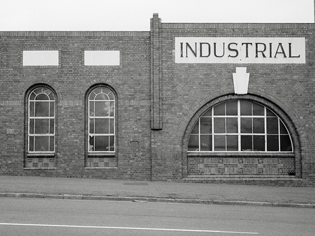
Trail Point 2 - Industrial Pavilion
The RNA was established in 1875, with the first show held in 1876. An almost unbroken history of 140 years of Exhibitions had begun. The foundation stone for the Industrial Pavilion was laid on 5 March, 1937, and the iconic Pavilion with its decorative façade of red brickwork played an important role in the Exhibition since it opened in 1939. It also served as the popular showbag pavilion. While it was recently transformed, the original brickwork and design elements have been incorporated into what is now known as the Royal International Convention Centre.

Trail Point 3 - Main Arena
The Main Arena is perhaps the most recognised and frequented site at the Brisbane Showgrounds. It bears the marks of competition and entertainment, the imprint of feet and hooves, fireworks and Grand Parades, which have all helped shape the history of the Showgrounds. In addition to some of Australia’s most talented riders, bovine and equine royalty, fireworks, race cars and processions, the Main Arena has also seen legendary sports matches, the first inter-colonial QLD and NSW tennis game, motorcycle speedway races and the first aeroplane flight ever seen in Brisbane. It is the true heartbeat of the Ekka.
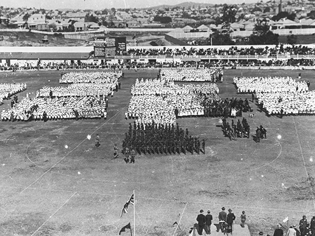
Trail Point 4 - War and the Brisbane Showgrounds
The Brisbane Showgrounds has always championed Queensland’s prosperity and brought together country and city. It’s also proudly patriotic, which was evident during times of war. From the Boer War to the Second World War, the Showgrounds has played a pivotal role in supporting the war efforts including providing training camps for Queensland soldiers in WW1, accommodation for American troops, medal presentations for war veterans and returned servicemen, and as an isolation hospital during the Spanish Influenza epidemic. The Royal Queensland Show (Ekka) was cancelled twice, for the Spanish Influenza and in 1942 during the Second World War.
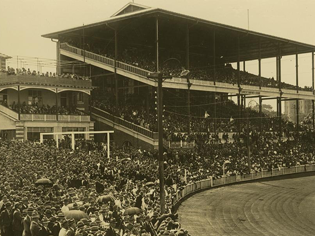
Trail Point 5 - Ernest Baynes Stand
The historic Ernest Baynes Stand was opened in 1923, to replace the original grandstand erected in 1885. Designed by architect Richard Gailey Jnr, it was constructed of a steel frame faced with brick and sat up to 7,000 people in its two tiers. It was named in honour of Brisbane businessman Ernest Baynes, who had been a Council member, the Chairman and then the President from 1924 to 1930. It boasted a dining room under the Stand with seating for 700 people, the latest cooking appliances, and an electric dishwasher capable of washing and drying 800 plates in 15 minutes.
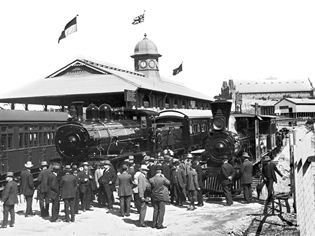
Trail Point 6 - Trams and Transport
More than 30 million people have travelled to the Brisbane Showgrounds since the very first Royal Queensland Show (Ekka) in 1876, when crowds made their way by horse, private carriage and omnibus. Almost a decade later, in 1885, a horse-drawn tram service commenced. The last tram service to the show ran in 1967. Trains were also a popular transport choice with the original Exhibition station built in 1881. A new station opened in 1967 and it was refurbished in 1992. Today, Exhibition railway station is still used during Ekka and occasionally operates when other events are held at the Showgrounds.
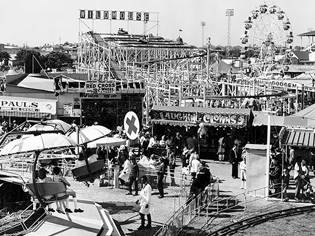
Trail Point 7 - Sideshow Alley
Sideshow Alley is known for its thrills - a place where people enjoy the rides and games at the Royal Queensland Show (Ekka). The area first came about in 1877, when a merry-go-round featured at the second ever show. By the 1908 show, Sideshow Alley was well established with a giant wheel, merry-go-round and entertainment. In 1969, the first Skymaster Ferris Wheel was introduced and remains an iconic attraction. In 2000, the Inner City Bypass was constructed and Sideshow Alley was redeveloped. Today, it features rides, games and showbags during Ekka and is used as an event space.

Trail Point 8 - Cattle
From the first Royal Queensland Show (Ekka) in 1876, cattle competitions have been a highlight. The first show featured three breeds of beef cattle - Durham, Hereford and Devon – and ribbons were awarded for first and second. Today, almost 30 breeds and an average of 1,600 head of beef cattle descend on the Brisbane Showgrounds during Ekka to be paraded, judged and displayed. The Stud Beef Competition is the largest showing of stud beef in the Southern Hemisphere while the Dairy Cattle Competition, attracting an average of 250 animals, is one of the largest showings of dairy cattle in Australia.
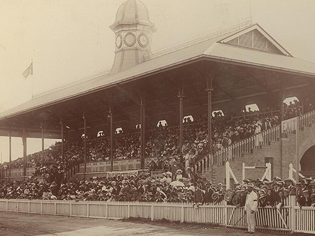
Trail Point 9 - John MacDonald Stand
The John MacDonald Stand is the earliest surviving ringside structure. It was designed by Brisbane architect Claude William Chambers and erected in 1906 for the sum of £6248. In 1923, it was re-named in honour of John MacDonald, who was the RNA Chairman from 1901– 1920. The brick structure features an ornate dome with a four-faced clock, visible from almost every part of the Exhibition Ground. In 1985, the stand underwent refurbishment, however the arc of the central bay still boasts the name JOHN MACDONALD STAND and shades its thousands of occupants while they watch events in the Main Arena.
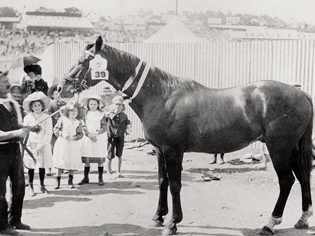
Trail Point 10 - Horses
Horses have been competing at the Royal Queensland Show (Ekka) since the very first Ekka in 1876. At this show, silver cups were awarded to the best stallion and best heavy draught stallion. Today, the Horse Competition attracts an average of 2,500 entries, making it one of the largest Ekka competitions. More than 15 breeds of horses are displayed over the many competition sections. In 1898, Showjumping was one of the most spectacular attractions held in the Main Arena, drawing large crowds. In 2006, Thoroughbred Day was introduced, to showcase the beauty and versatility of thoroughbred horses.
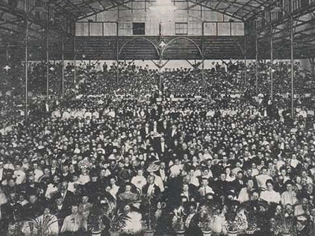
Trail Point 11 - John Reid Pavilion
John Reid Pavilion is the oldest building in the Brisbane Showgrounds, dating back to the early 1900s. It was designed by architect William Hodgen and built in Toowoomba in 1904. Originally named the Austral Hall, the building was purchased and re-erected at the Showgrounds in 1917. The building was renamed the John Reid Pavilion in 1919, following the death of well respected business leader John Reid. The John Reid Annexe, constructed in 1925, is situated behind the pavilion and is part of the John Reid complex. Today, John Reid Pavilion is used as a venue space for events at the Showgrounds.

Trail Point 12 - King Street
King Street is a 300 metre street linking St Pauls Terrace and Gregory Terrace. Construction commenced in 2014, as part of the RNA’s $2.9 billion Brisbane Showgrounds Regeneration Project. The nine-storey Kingsgate commercial tower was the first building to open on King Street in June, 2015. Major milestones were also reached in February, 2016, with the street opening to traffic, and Rydges Hotel featuring a bar and restaurant opening for business. This was the first year onsite accommodation could be offered to Showgrounds guests. More restaurants began opening from August, 2016, transforming the street into a vibrant dining precinct.









